Analyzing the Impact and Solutions for Fake News on Social Media
VerifiedAdded on 2023/04/21
|6
|1247
|163
Essay
AI Summary
This essay delves into the multifaceted issue of fake news within the realm of social media. It begins by defining fake news and its various forms, highlighting its deliberate nature and potential to misinform and deceive. The essay then explores the significant impact of fake news on people's daily lives, including its role in polarizing society, particularly during political events, and its detrimental effects on democracy and trust in media. Furthermore, the essay examines potential solutions to combat the spread of fake news, such as efforts by social media platforms and fact-checkers. It also discusses the impact of fake news on the credibility of news reporting and the role of removing censorship. The essay uses real-world examples, like the case of Saleh Sulaiman and the Malaysian Prime Minister, to illustrate the consequences of fake news. Finally, it concludes by emphasizing the need for a better understanding of fake news and the importance of implementing effective strategies to mitigate its negative effects.
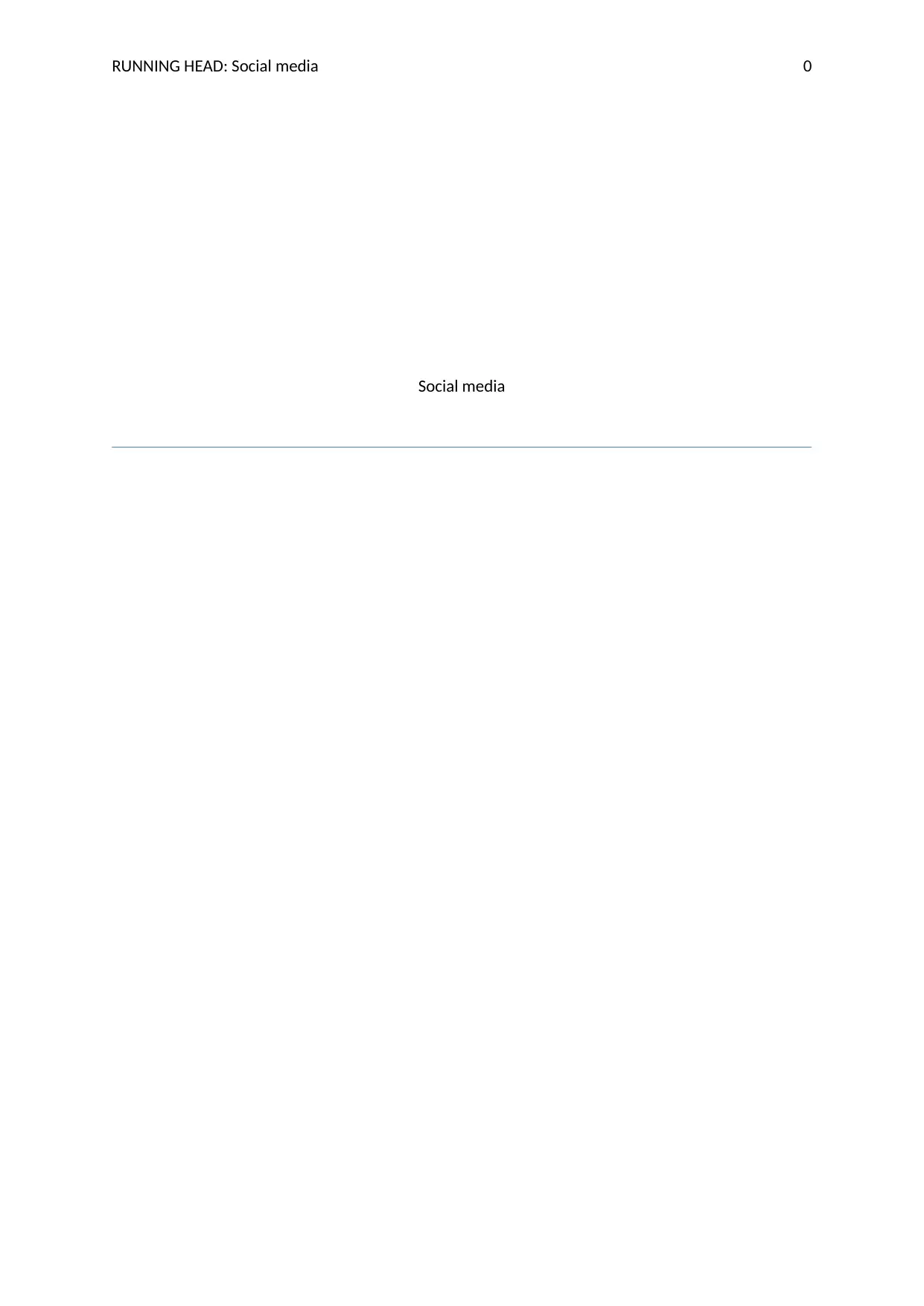
RUNNING HEAD: Social media 0
Social media
Social media
Paraphrase This Document
Need a fresh take? Get an instant paraphrase of this document with our AI Paraphraser

Social media 1
Contents
Fake news...................................................................................................................................2
Impact of fake news on people’s daily life................................................................................2
Ways to solve fake news............................................................................................................3
The credibility of news reporting be tainted due to fake news..................................................3
The role of removing censorship................................................................................................4
Contents
Fake news...................................................................................................................................2
Impact of fake news on people’s daily life................................................................................2
Ways to solve fake news............................................................................................................3
The credibility of news reporting be tainted due to fake news..................................................3
The role of removing censorship................................................................................................4
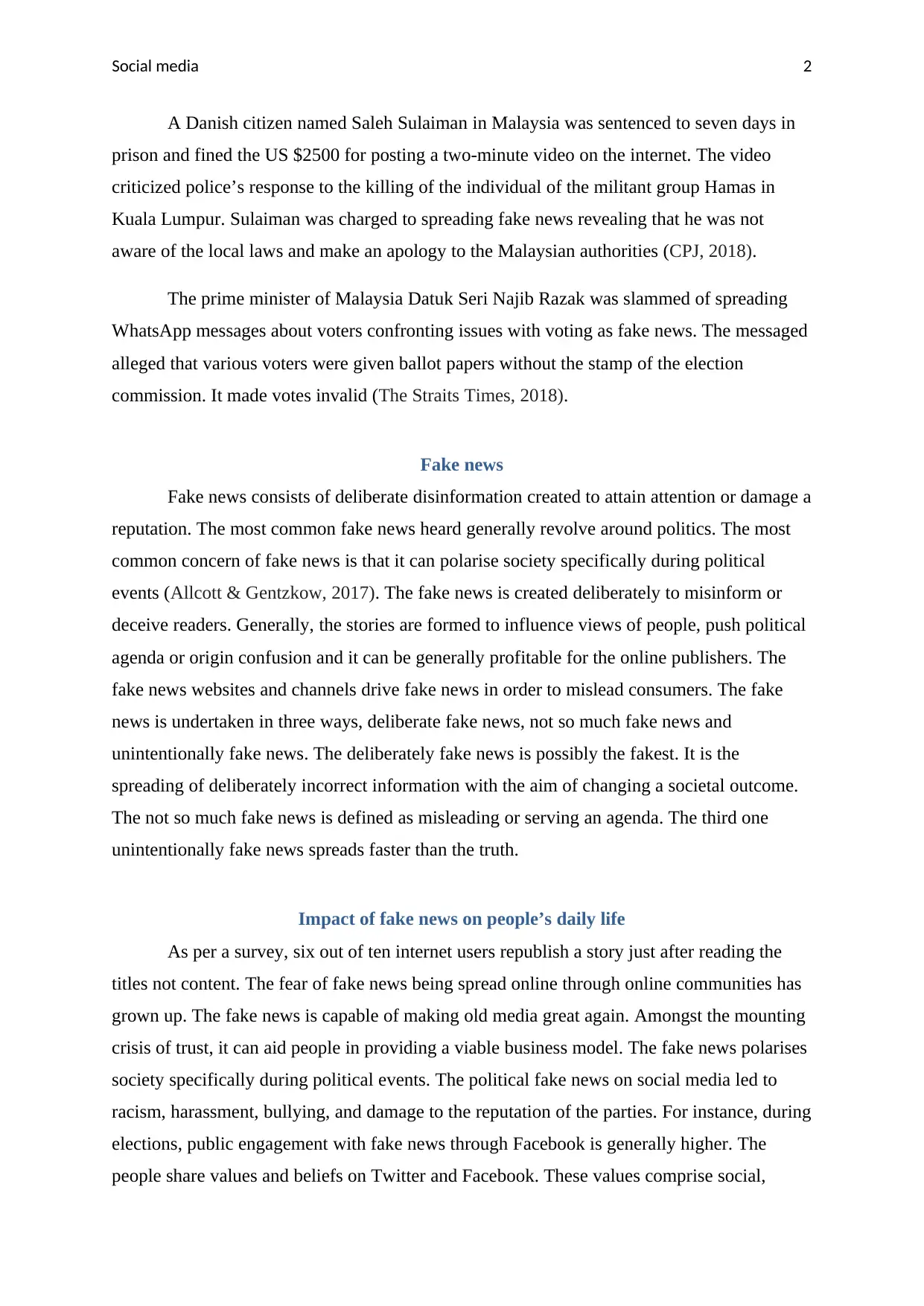
Social media 2
A Danish citizen named Saleh Sulaiman in Malaysia was sentenced to seven days in
prison and fined the US $2500 for posting a two-minute video on the internet. The video
criticized police’s response to the killing of the individual of the militant group Hamas in
Kuala Lumpur. Sulaiman was charged to spreading fake news revealing that he was not
aware of the local laws and make an apology to the Malaysian authorities (CPJ, 2018).
The prime minister of Malaysia Datuk Seri Najib Razak was slammed of spreading
WhatsApp messages about voters confronting issues with voting as fake news. The messaged
alleged that various voters were given ballot papers without the stamp of the election
commission. It made votes invalid (The Straits Times, 2018).
Fake news
Fake news consists of deliberate disinformation created to attain attention or damage a
reputation. The most common fake news heard generally revolve around politics. The most
common concern of fake news is that it can polarise society specifically during political
events (Allcott & Gentzkow, 2017). The fake news is created deliberately to misinform or
deceive readers. Generally, the stories are formed to influence views of people, push political
agenda or origin confusion and it can be generally profitable for the online publishers. The
fake news websites and channels drive fake news in order to mislead consumers. The fake
news is undertaken in three ways, deliberate fake news, not so much fake news and
unintentionally fake news. The deliberately fake news is possibly the fakest. It is the
spreading of deliberately incorrect information with the aim of changing a societal outcome.
The not so much fake news is defined as misleading or serving an agenda. The third one
unintentionally fake news spreads faster than the truth.
Impact of fake news on people’s daily life
As per a survey, six out of ten internet users republish a story just after reading the
titles not content. The fear of fake news being spread online through online communities has
grown up. The fake news is capable of making old media great again. Amongst the mounting
crisis of trust, it can aid people in providing a viable business model. The fake news polarises
society specifically during political events. The political fake news on social media led to
racism, harassment, bullying, and damage to the reputation of the parties. For instance, during
elections, public engagement with fake news through Facebook is generally higher. The
people share values and beliefs on Twitter and Facebook. These values comprise social,
A Danish citizen named Saleh Sulaiman in Malaysia was sentenced to seven days in
prison and fined the US $2500 for posting a two-minute video on the internet. The video
criticized police’s response to the killing of the individual of the militant group Hamas in
Kuala Lumpur. Sulaiman was charged to spreading fake news revealing that he was not
aware of the local laws and make an apology to the Malaysian authorities (CPJ, 2018).
The prime minister of Malaysia Datuk Seri Najib Razak was slammed of spreading
WhatsApp messages about voters confronting issues with voting as fake news. The messaged
alleged that various voters were given ballot papers without the stamp of the election
commission. It made votes invalid (The Straits Times, 2018).
Fake news
Fake news consists of deliberate disinformation created to attain attention or damage a
reputation. The most common fake news heard generally revolve around politics. The most
common concern of fake news is that it can polarise society specifically during political
events (Allcott & Gentzkow, 2017). The fake news is created deliberately to misinform or
deceive readers. Generally, the stories are formed to influence views of people, push political
agenda or origin confusion and it can be generally profitable for the online publishers. The
fake news websites and channels drive fake news in order to mislead consumers. The fake
news is undertaken in three ways, deliberate fake news, not so much fake news and
unintentionally fake news. The deliberately fake news is possibly the fakest. It is the
spreading of deliberately incorrect information with the aim of changing a societal outcome.
The not so much fake news is defined as misleading or serving an agenda. The third one
unintentionally fake news spreads faster than the truth.
Impact of fake news on people’s daily life
As per a survey, six out of ten internet users republish a story just after reading the
titles not content. The fear of fake news being spread online through online communities has
grown up. The fake news is capable of making old media great again. Amongst the mounting
crisis of trust, it can aid people in providing a viable business model. The fake news polarises
society specifically during political events. The political fake news on social media led to
racism, harassment, bullying, and damage to the reputation of the parties. For instance, during
elections, public engagement with fake news through Facebook is generally higher. The
people share values and beliefs on Twitter and Facebook. These values comprise social,
⊘ This is a preview!⊘
Do you want full access?
Subscribe today to unlock all pages.

Trusted by 1+ million students worldwide
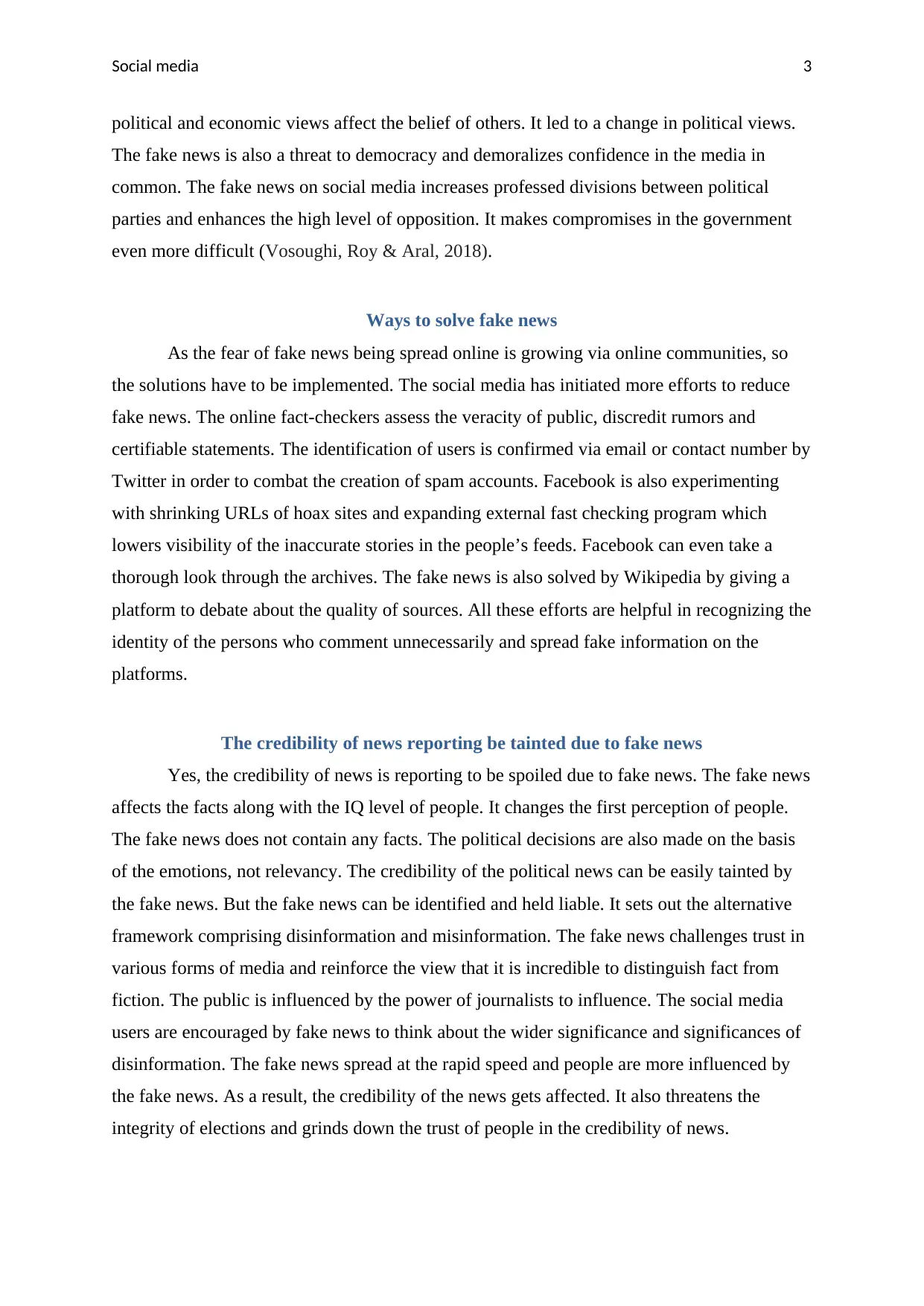
Social media 3
political and economic views affect the belief of others. It led to a change in political views.
The fake news is also a threat to democracy and demoralizes confidence in the media in
common. The fake news on social media increases professed divisions between political
parties and enhances the high level of opposition. It makes compromises in the government
even more difficult (Vosoughi, Roy & Aral, 2018).
Ways to solve fake news
As the fear of fake news being spread online is growing via online communities, so
the solutions have to be implemented. The social media has initiated more efforts to reduce
fake news. The online fact-checkers assess the veracity of public, discredit rumors and
certifiable statements. The identification of users is confirmed via email or contact number by
Twitter in order to combat the creation of spam accounts. Facebook is also experimenting
with shrinking URLs of hoax sites and expanding external fast checking program which
lowers visibility of the inaccurate stories in the people’s feeds. Facebook can even take a
thorough look through the archives. The fake news is also solved by Wikipedia by giving a
platform to debate about the quality of sources. All these efforts are helpful in recognizing the
identity of the persons who comment unnecessarily and spread fake information on the
platforms.
The credibility of news reporting be tainted due to fake news
Yes, the credibility of news is reporting to be spoiled due to fake news. The fake news
affects the facts along with the IQ level of people. It changes the first perception of people.
The fake news does not contain any facts. The political decisions are also made on the basis
of the emotions, not relevancy. The credibility of the political news can be easily tainted by
the fake news. But the fake news can be identified and held liable. It sets out the alternative
framework comprising disinformation and misinformation. The fake news challenges trust in
various forms of media and reinforce the view that it is incredible to distinguish fact from
fiction. The public is influenced by the power of journalists to influence. The social media
users are encouraged by fake news to think about the wider significance and significances of
disinformation. The fake news spread at the rapid speed and people are more influenced by
the fake news. As a result, the credibility of the news gets affected. It also threatens the
integrity of elections and grinds down the trust of people in the credibility of news.
political and economic views affect the belief of others. It led to a change in political views.
The fake news is also a threat to democracy and demoralizes confidence in the media in
common. The fake news on social media increases professed divisions between political
parties and enhances the high level of opposition. It makes compromises in the government
even more difficult (Vosoughi, Roy & Aral, 2018).
Ways to solve fake news
As the fear of fake news being spread online is growing via online communities, so
the solutions have to be implemented. The social media has initiated more efforts to reduce
fake news. The online fact-checkers assess the veracity of public, discredit rumors and
certifiable statements. The identification of users is confirmed via email or contact number by
Twitter in order to combat the creation of spam accounts. Facebook is also experimenting
with shrinking URLs of hoax sites and expanding external fast checking program which
lowers visibility of the inaccurate stories in the people’s feeds. Facebook can even take a
thorough look through the archives. The fake news is also solved by Wikipedia by giving a
platform to debate about the quality of sources. All these efforts are helpful in recognizing the
identity of the persons who comment unnecessarily and spread fake information on the
platforms.
The credibility of news reporting be tainted due to fake news
Yes, the credibility of news is reporting to be spoiled due to fake news. The fake news
affects the facts along with the IQ level of people. It changes the first perception of people.
The fake news does not contain any facts. The political decisions are also made on the basis
of the emotions, not relevancy. The credibility of the political news can be easily tainted by
the fake news. But the fake news can be identified and held liable. It sets out the alternative
framework comprising disinformation and misinformation. The fake news challenges trust in
various forms of media and reinforce the view that it is incredible to distinguish fact from
fiction. The public is influenced by the power of journalists to influence. The social media
users are encouraged by fake news to think about the wider significance and significances of
disinformation. The fake news spread at the rapid speed and people are more influenced by
the fake news. As a result, the credibility of the news gets affected. It also threatens the
integrity of elections and grinds down the trust of people in the credibility of news.
Paraphrase This Document
Need a fresh take? Get an instant paraphrase of this document with our AI Paraphraser
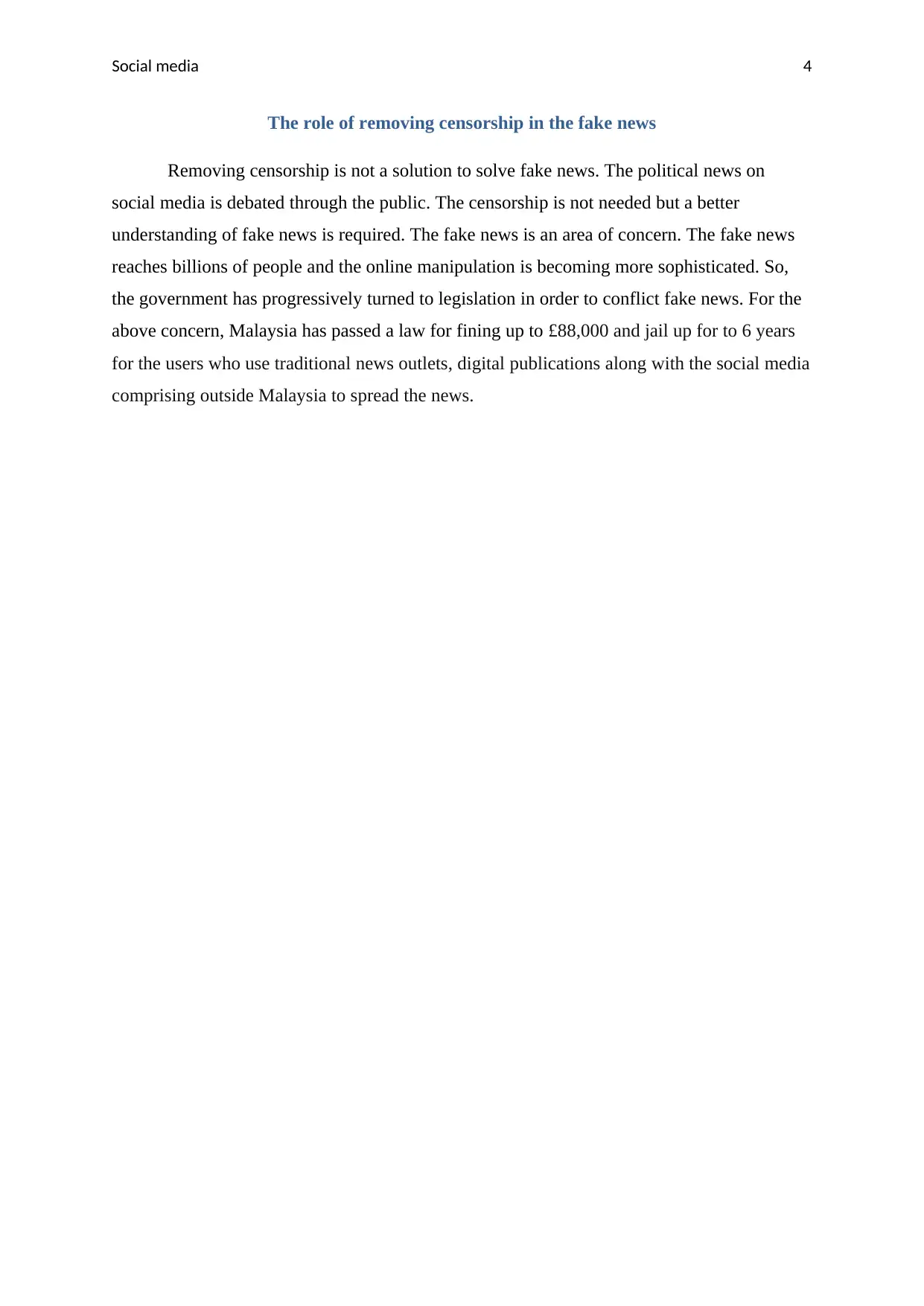
Social media 4
The role of removing censorship in the fake news
Removing censorship is not a solution to solve fake news. The political news on
social media is debated through the public. The censorship is not needed but a better
understanding of fake news is required. The fake news is an area of concern. The fake news
reaches billions of people and the online manipulation is becoming more sophisticated. So,
the government has progressively turned to legislation in order to conflict fake news. For the
above concern, Malaysia has passed a law for fining up to £88,000 and jail up for to 6 years
for the users who use traditional news outlets, digital publications along with the social media
comprising outside Malaysia to spread the news.
The role of removing censorship in the fake news
Removing censorship is not a solution to solve fake news. The political news on
social media is debated through the public. The censorship is not needed but a better
understanding of fake news is required. The fake news is an area of concern. The fake news
reaches billions of people and the online manipulation is becoming more sophisticated. So,
the government has progressively turned to legislation in order to conflict fake news. For the
above concern, Malaysia has passed a law for fining up to £88,000 and jail up for to 6 years
for the users who use traditional news outlets, digital publications along with the social media
comprising outside Malaysia to spread the news.
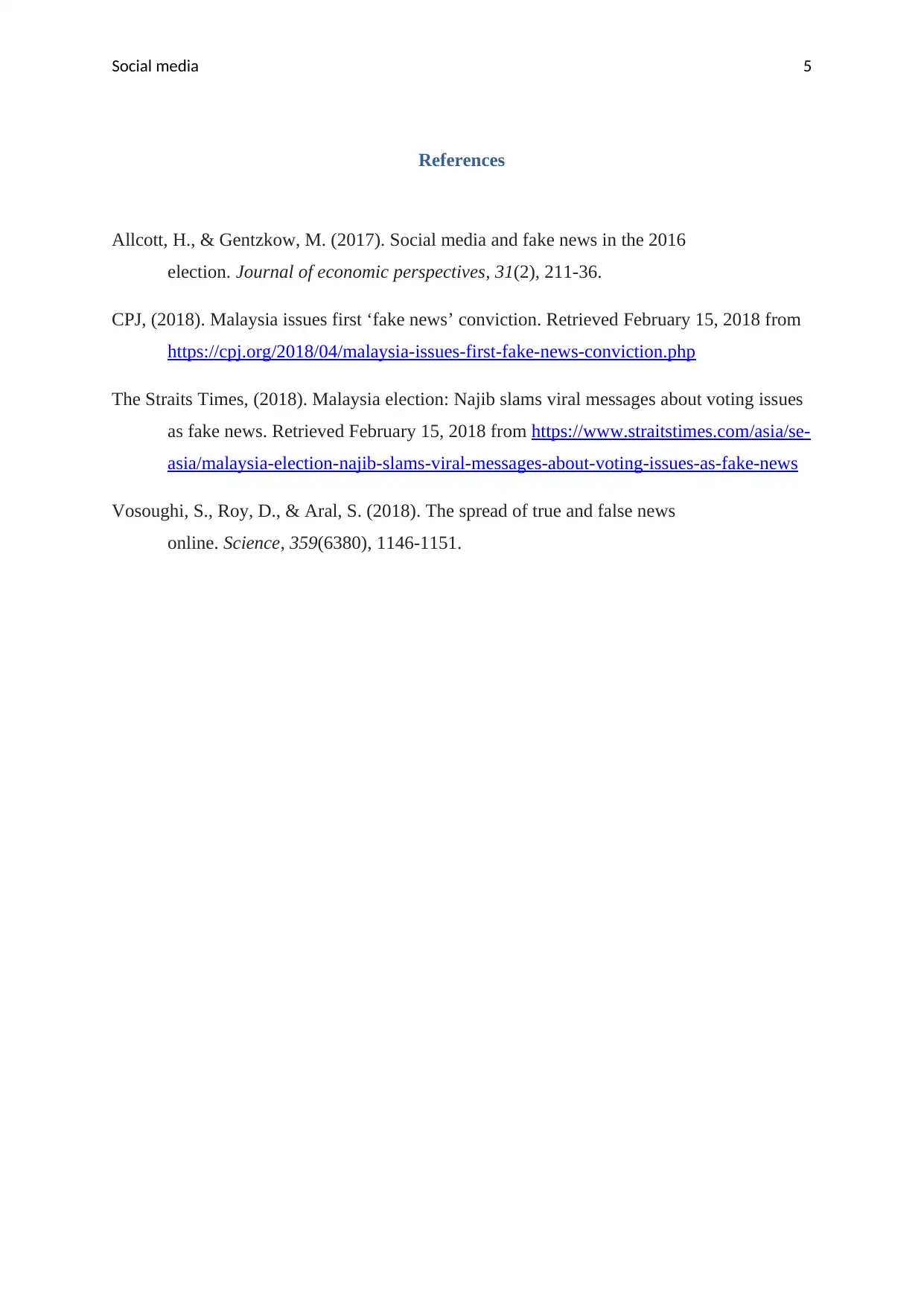
Social media 5
References
Allcott, H., & Gentzkow, M. (2017). Social media and fake news in the 2016
election. Journal of economic perspectives, 31(2), 211-36.
CPJ, (2018). Malaysia issues first ‘fake news’ conviction. Retrieved February 15, 2018 from
https://cpj.org/2018/04/malaysia-issues-first-fake-news-conviction.php
The Straits Times, (2018). Malaysia election: Najib slams viral messages about voting issues
as fake news. Retrieved February 15, 2018 from https://www.straitstimes.com/asia/se-
asia/malaysia-election-najib-slams-viral-messages-about-voting-issues-as-fake-news
Vosoughi, S., Roy, D., & Aral, S. (2018). The spread of true and false news
online. Science, 359(6380), 1146-1151.
References
Allcott, H., & Gentzkow, M. (2017). Social media and fake news in the 2016
election. Journal of economic perspectives, 31(2), 211-36.
CPJ, (2018). Malaysia issues first ‘fake news’ conviction. Retrieved February 15, 2018 from
https://cpj.org/2018/04/malaysia-issues-first-fake-news-conviction.php
The Straits Times, (2018). Malaysia election: Najib slams viral messages about voting issues
as fake news. Retrieved February 15, 2018 from https://www.straitstimes.com/asia/se-
asia/malaysia-election-najib-slams-viral-messages-about-voting-issues-as-fake-news
Vosoughi, S., Roy, D., & Aral, S. (2018). The spread of true and false news
online. Science, 359(6380), 1146-1151.
⊘ This is a preview!⊘
Do you want full access?
Subscribe today to unlock all pages.

Trusted by 1+ million students worldwide
1 out of 6
Related Documents
Your All-in-One AI-Powered Toolkit for Academic Success.
+13062052269
info@desklib.com
Available 24*7 on WhatsApp / Email
![[object Object]](/_next/static/media/star-bottom.7253800d.svg)
Unlock your academic potential
Copyright © 2020–2025 A2Z Services. All Rights Reserved. Developed and managed by ZUCOL.





